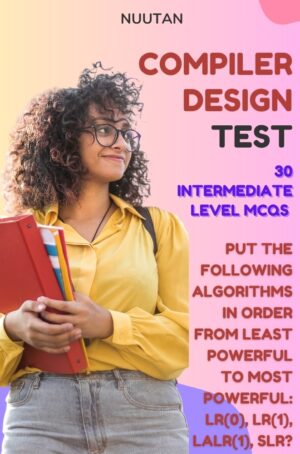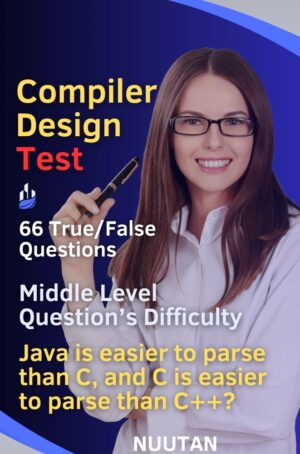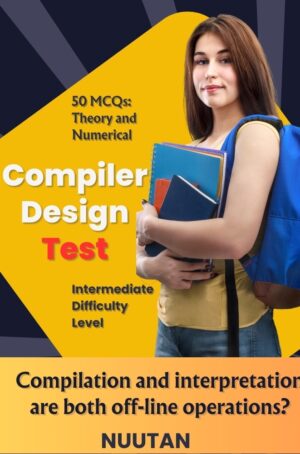Description
Advance Compiler Test – Master the Challenge with our Comprehensive 1-Hour Online Assessment
Get ready to do well on the Advance Compiler Test:
Introducing the Advance Compiler Test. It is a 1-hour online assessment that will push your Compiler Design skills to new heights. Prepare to master the challenge and prove your expertise!
Aim High for Success on the Advance Compiler Test
Score a minimum of 60% in the “Advance Compiler Test” to showcase your prowess in Compiler Design. Aim high and unlock a world of opportunities with this prestigious certification.
Ideal for Students All Over the World, the Advance Compiler Test
Whether you’re studying Compiler Design anywhere in the world or pursuing B.Tech, M.Tech, BCA, or MCA in India, our test is your gateway to academic excellence.
Your Way to Succeed in Competitive Exams Begins with the Advance Compiler Test
Preparing for GATE, NET, SLET, DRDO, or ISRO? The “Advance Compiler Test” is your secret weapon to excel in these competitive exams. Sharpen your skills and stand out from the crowd!
Copyright:
© Nuutan.com: All rights reserved. Unauthorized copying, distribution, or reproduction of this content is strictly prohibited.
Don’t miss this chance to elevate your Compiler Design knowledge. Experience the “Advance Compiler Test” and embark on a journey of knowledge, growth, and success! Experience the “Advance Compiler Test” today and unlock your full potential in Compiler Design. Prepare to conquer challenges, achieve excellence, and open doors to a bright future. Limited slots are available, so act fast to secure your spot!
Discover an Ocean of Educational Resources! We provide a wide variety of learning materials that you can access through our internal links.
- Nuutan.com is your gateway to a world of information and academic accomplishment. Books in e-book form, multiple-choice question-based online practice tests, practice sets, lecture notes, and essays on a wide range of topics, plus much more!
- Nuutan.com is your one-stop-shop for all kinds of academic e-books, and it will greatly facilitate your educational path.
https://www.nuutan.com/product-category/k12-cuet-iit-jee-neet-gate-university-subjects
- Online multiple-choice tests are available for a variety of subjects on Nuutan.com.
https://www.nuutan.com/product-category/multiple-choice-question
- The Practice Sets on Nuutan.com will improve your performance in any situation.
https://www.nuutan.com/product-category/k12-cuet-iit-jee-neet-gate-cs-btech-mca
- The in-depth lecture notes available on Nuutan.com will significantly improve your academic performance.
https://www.nuutan.com/product-category/k12-cuet-iit-jee-neet-gate-bca-mca-btech-mtech
- Show off your writing chops and gain an edge in educational settings and in the workplace with Profound Essays from Nuutan.com.
https://www.nuutan.com/product-category/k12-competitive-exams-essays
- Nuutan.com is a treasure trove of knowledge thanks to its free academic articles covering a wide variety of subjects. Start your academic engine!
https://www.nuutan.com/nuutans-diary
- Discover our roots and learn how Nuutan.com came to be. Read up about us on the “About Us” page of our website!
https://www.nuutan.com/about-us
- Embrace a Future of Knowledge and Empowerment! is the vision of the future that Nuutan.com has unveiled.
- Become an author by publishing your work on the Nuutan.com platform.
https://www.nuutan.com/create-a-publication-with-us
The External Link Related to This Academic Product:
- GOOGLE BOOKS: Here are a few Google links to help you learn about Compiler Design, including Automata Theory, which is also very helpful for getting a good grasp of Compiler Design.
(1) Mastering Compiler Design: Your Ultimate MCQ Guide to Exam Success
https://books.google.co.in/books/about/Compiler_Design_MCQ_Book.html?id=oZuLEAAAQBAJ&redir_esc=y
(2) Compiler Design MCQs: An Ultimate Practice Book
(3) Automata Theory – A Step-by-Step Approach (Lab/Practice Work with Solution)
- YOUTUBE VIDEO:
https://www.youtube.com/watch?v=5yFdTSbqsWE
- SCRIBD:
https://www.scribd.com/document/489307274/compiler-design-multiple-choice-questions-answers-1-pdf#
- ACADEMIA:
https://www.academia.edu/36463069/Compiler_mcq
- SLIDESHARE:
https://www.slideshare.net/SatyamJaiswal54/compiler-design-quiz
- COURSE HERO:
https://www.coursehero.com/file/129056939/Compiler-MCQ-CS-702pdf/
- BYJU’S EXAM PREP:
https://byjus.com/gate/compiler-design-mcqs/
- DOCSITY:
https://www.docsity.com/en/compiler-design-mcq/7356849/
- OPENGENUS:
https://iq.opengenus.org/compiler-design-mcq/
- STUDOCU:
- GRADUATE APTITUDE TEST IN ENGINEERING (GATE) 2024:
- UGC NET ONLINE (SYLLABUS AVAILABLE ONLINE):
- DRDO (CAREER WEBSITE) – RECRUITMENT AND ASSESSMENT CENTRE (RAC):
https://rac.gov.in/index.php?lang=en&id=0
- ISRO (CAREER WEBSITE):
https://www.isro.gov.in/Careers.html
- STATE LEVEL ELIGIBILITY TEST (SLET) – ASSAM NE REGION:
- STANFORD ONLINE:
https://online.stanford.edu/courses/soe-ycscs1-compilers
- IEEE XPLORE (COMPILER DESIGN RESEARCH PAPERS):
https://ieeexplore.ieee.org/document/7814827









